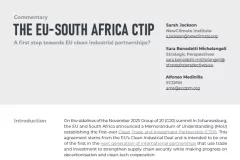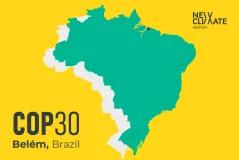One of the most fundamental questions of a future international agreement on climate change will be on which countries will contribute how much to the global effort to combat climate change. With the first round of discussions under the Ad-hoc Durban Platform in 2015 in Geneva in early February, Parties have heralded the next critical phase of the negotiations leading towards a new global climate agreement which is to cover numerous elements such as mitigation, adaptation, finance, loss & damage and others. Guided by the principle of Common But Differentiated Responsibilities and Respective Capabilities (CBDRRC), countries are also discussing the level of effort different countries should present in their Intended Nationally Determined Contributions (INDC) regarding these elements.
The categorisation of countries in two worlds has been the dominant method for differentiation in the international climate regime in the past. The United Nations Framework Convention on Climate Change (UNFCCC), adopted in 1992 includes a list of developed countries with special responsibilities and duties, its Annex I. This categorisation turned out to be unchangeable even after more than 20 years and manifested itself. In the Kyoto Protocol of 1997, Annex I countries have committed to binding absolute emission reduction targets, and various other countries have taken on voluntary actions.
A major breakthrough was in Durban in 2011 to agree to embark on a new agreement for all countries, to break this rigid categorisation. While there is a common understanding that responsibilities and capabilities still vary and that this should be reflected in the new agreement, opinions drift apart when speaking about how to operationalise this general principle.
This blog summarises the current discussion around such differentiation. It focuses on the question how to distinguish the countries, but does not describe which efforts would be adequate for the different countries.
Options for differentiating efforts
The following paragraphs describe the options currently included in negotiation texts for the new agreement or in submissions of countries. It further explains some potential implications of these options on the overall agreement.
Self-differentiation
One option could be to leave the differentiation up to the countries, where they simply propose self-determined actions. This element is already represented in the process to submit INDCs, where “countries in a position to do so” are invited to submit their INDCs by March 2015, without further guidance of what would put a country in such a position.
The risk in this approach is that the country driven proposals are seen as unfair by some, one country doing much more than another country in the same circumstances. As a result, countries may be cautious with their offers and the risk is high that the common target to hold temperature increase below 2°C would be missed by far. On the other hand, countries are asked to propose INDCs in line with their national circumstances and capabilities. Considering other benefits on the national level may actually lead to more ambitious efforts of less developed countries than implying certain standard rules.
Self-differentiation could be complemented by agreeing on minimum general rules for all, e.g. “no-backsliding”, meaning that countries should not reduce the ambition of their efforts in the new agreement compared to current commitments. Switzerland's submission for example suggests a combination of self-determination and guiding elements.
Division between developing/developed countries and least developed countries & small island states The draft texts resulting from the Conference of Parties in Lima in December 2014 mostly differentiated between “developed” and “developing countries” without further explanation how these groups would be defined. Further, additional leeway was granted to Least Developed Countries and Small Island States.
Under this option the distinction between developed and developing countries is left ambiguous on purpose. Countries could decide themselves which group they want to belong to. Potentially, this could decrease the ambition of the overall agreement as countries could grade themselves down to avoid stringent actions, on the other hand it puts less emphasis on differentiation, and is thus less of an excuse for countries to lean back.
Cleary define country groupings in annexes
The use of “Annexes” came up again during the ADP sessions in February 2015 and is now included as an option in the current draft text.
Lists of countries have the disadvantage of building a rigid divide between the country groups, which for pre 2020 mitigation commitments has led to continuous conflicts and eventually a very limited scope of the Kyoto Protocol. To prevent such a lock-in, regular or continuous revisions or inclusion by a formula would be essential (see section “Differentiation in the long run”).
The critical element with lists is to decide who is on it. For example, Ethiopia raised the option of differentiating between “Annex I” and “Annex II” countries considering per capita emissions and income. The Unites States proposed to include a placeholder for an Annex X, determined through emissions and economic trends, and an Annex Y, to be determined through capabilities and evolving economic circumstances. St. Lucia picked up this discussion by suggesting an additional placeholder for an Annex Z including countries which are not part of Annex X nor Y.
Differentiation in the long run
While countries are starting from a very different point, they eventually have to be at the same level - zero net emissions. The recent IPCC report made clear that a global phase out of GHG emissions will be necessary in order to hold temperature increase below 2° with a likely chance. This means that in the long-term, emissions in all countries need to decrease substantially, approaching net zero emissions. While the path towards this goal can be differentiated, the endpoint is common to all. The INDCs anchored in the 2015 agreement this year could also provide a basis for such a common end point. The question is thus if and how countries would progress from a relatively high degree of differentiation to this common end point at some point in the future.
One option for differentiation over time could be a reconsideration of countries responsibilities and capabilities, either based on previously agreed indicators or in a national process. This could then result in adjustments of the commitments. Under the assumptions that the difference of wealth between countries decreases over time, this would lead to a common end point. Another option is to agree on a converging level of ambition from the start (e.g. phase out/100% RE or x t per capita in the long term), which all countries could consider including in their initial INDC submission.
Emerging draft INDCs
While there is no agreement yet on differentiation, many countries are in the process of preparing their INDCs already and are thinking about the effort required by them.
South Africa for example presented its process for developing the INDCs during the 2nd African Regional Technical Dialogue on INDCs. To determine the required level of effort, it works with a non-public Equity Reference Framework, which however has not been agreed on with other countries. Chile elaborated three scenarios of different efforts for the development of its current proposal, which are mainly distinguished through mitigation costs and potentials (as described in the background report of the MAPS Chile project). Other criteria were for example synergies with existing activities, the inclusion of most relevant sectors, and “requirements by science”.
Further reading
More information on differentiation of post 2020 commitments can be found in the following reports:
Vieweg et al. (2014). Squaring the circle of Mitigation Adequacy and Equity: Options and Perspectives
Morgen et al. (2014). Elements and ideas for the 2015 Paris agreement







